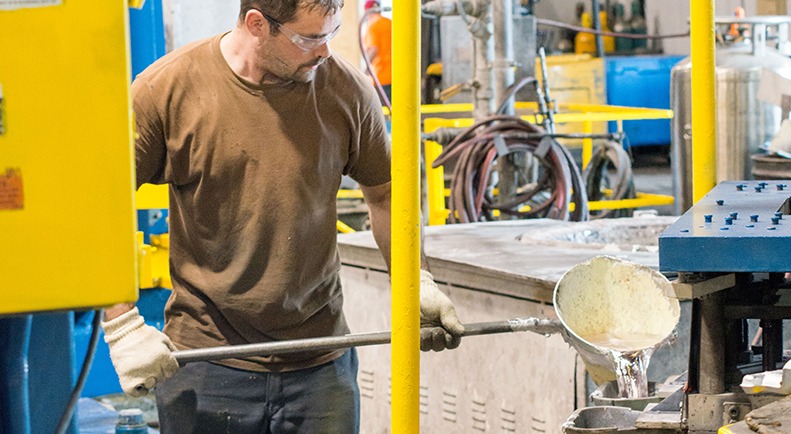Permanent mold cast tooling is used to shape liquid metal alloy into some of the strongest casting products on the market.
Our foundry works with large companies with precise tooling demands as well as mom and pop shops that need help to plan and execute their casting projects. No matter where you’re coming from, you’ll get the same advice and service from the permanent mold tooling experts.
The term tooling refers to project-specific molds, which includes the mold cavities, gating and ejector systems. Every aspect of your product design and production goals will help dictate the tooling system, so it’s important to communicate your needs and expectations with experts who fully understand the permanent mold metal casting process and how it can be optimized.
Investment considerations
Permanent mold tooling investments are generally $10,000 to $90,000, with a lead time of 10 to 12 weeks. Each steel mold can be used to make 40,000 castings or more with specialized designs and maintenance. The cost and lead times increase for complex products that require additional cavity pools, inserts or other design elements.
The tooling investment required for permanent mold casting is a good middle ground between methods like sand and die casting. It is a larger, but longer-term investment than sand casting. On the other hand, it’s much cheaper than die casting, because permanent mold casting is induced by gravity and doesn’t include aspects like pressurized metal injection.
Permanent mold casting is a process for producing castings using a reusable mold. The casting process involves pouring molten aluminum into a mold where it cools and solidifies. The mold is opened, the casting removed and the mold reused.
Permanent molds are made by milling cavities out of tool steel using CNC or electrical discharge machines.
Steel molds are durable and produce consistent castings with tight tolerances and polished mold walls that create exceptional as-cast surface finishes. The mold mounting and ejector system are all part of the tool.
Fluid flow, air evacuation and solidification are a few of the variables that are taken into consideration in the mold design.
While all permanent mold casting is gravity-induced, there are multiple ways to introduce the molten metal to the mold using different pouring tactics and gating systems.
Pour methods

Dump pour (aka static standard) is what it sounds like, the molten metal is poured directly into the mold.
Tilt pour is like pouring a beer down the side of a glass to reduce turbulence (foam), except hydraulics tilt the mold which reduces porosity. Molten metal flows from the pour cup into the cavity as the mold is tilted vertically from its side and the cavity is gently filled.
With traditional tilt-pouring, the mold parting line is perpendicular to the floor during the solidification phase. But for reverse tilt, the parting line is parallel to the floor which allows the casting to be center poured.
Gating components
If you need a strong product with low porosity, especially for multi-cavity molds, tooling components like gates, risers and runners may be required to control how the molten metal flows into and throughout the mold.
Gating systems channel the molten metal into the mold so it smoothly and evenly fills the cavity. Risers are reservoirs in the gating system from which molten metal is fed to the casting to compensate for shrinkage as the metal solidifies. Runners slow and smooth the flow of molten metal into the mold and provide uniform flow rates into the individual cavities.
Ejection components
Shaping the perfect casting doesn’t do you any good if you can’t get it out of the mold without distortion and/or surface finish damage.
Draft angle is an important requirement in the permanent mold process. It is the angle or amount of slope to which the wall of a mold is tilted, making the opening of the casting wider than its base. This allows for efficient ejection of the casting from the mold. Products with “straight” side walls generally require a minimum 3 to 5 degrees. Proper draft also helps maintain the integrity of the mold coatings.
Mold or refractory coatings are applied to the molds to help release the casting, enhance surface finish and reduce casting defects.
Ejector pins mounted to a movable plate extend through the mold and push the casting out. They leave behind small imprints in the casting that can be removed by secondary operations if necessary or strategically placed in portions of the casting that hide those marks. The ejector system also has a return plate to pull the pins back to a ready position prior to the next pour.
Failing to implement a proper service plan could lead to a catastrophic failure that will put an abrupt halt on a long-term project. And poorly maintained tools also produce more faulty parts, increasing the overall piece price.
We clean, lubricate and polish the surface of your molds between production runs, monitoring for erosion, wear, metal buildup and other surface imperfections.
While we help design and create the molds and other tooling, they are the customer’s property. Tooling maintenance can be costly, but it’s a wise investment compared to the price of replacement components, and it’s something that we are proud of.
Reach out to the metalcast tooling experts and we’ll talk about all the little things that will make your project successful.
Let’s see how we can meet all of your production goals with a tooling system that will keep you in production for the long haul.